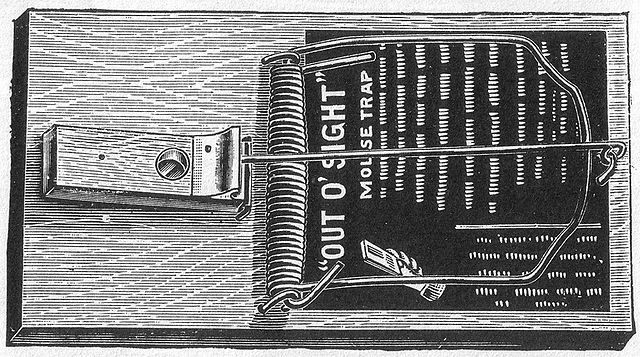FOUND: A 155-Year-Old Mousetrap Still Doing Its Job

A different type of 19th century mousetrap (Photo: The Iconographic Encyclopaedia of Science/Wikimedia)
When Colin Pullinger & Sons advertised an innovative, humane mousetrap in the 1860s, the company promised it would “last a lifetime.” One of their traps, in the collection of the Museum of English Rural Life at the University of Reading, more than lived up to that promise.
Recently, when an assistant curator was searching through the museum’s collection for objects connected to animals, the University of Reading reports on its Tumblr, he came across a dead mouse of comparatively recent provenance in the trap and sent out an email.*
“There appears to be a dead mouse in this mousetrap…Can you perhaps check whether it should be there and/or decide if having a dead mouse in the trap is the best way forward from a conservation perspective?”
Ok so a mouse got into the @MERLReading store & then got itself killed in 155-yr. old trap https://t.co/2Fqvt4TMEs pic.twitter.com/L2mdmQQB7A
— Adam Koszary (@AdamKoszary) February 3, 2016
The 155-year-old mousetrap was not baited, but it was still enticing enough to this ill-fated mouse that the creature crept inside. Once it was there, the trap’s see-saw mechanism kept it from going anywhere.
The museum is still deciding what the mouse’s ultimate destiny will be. They write:
“For the moment, the mouse remains in the trap while we decide what to do with it. One option is a dignified burial, another is to desiccate it or have it prepared to remain as a permanent feature of the mouse trap for our new displays.”
Either way, this mouse has now been part of history in a way that few others will ever be.
Museum w/ 150yo mousetrap finds out it still works (note: contains pictures of late mouse) https://t.co/eKFLnqYXa8 pic.twitter.com/dXBrWSUNts
— John Overholt (@john_overholt) February 3, 2016
























Follow us on Twitter to get the latest on the world's hidden wonders.
Like us on Facebook to get the latest on the world's hidden wonders.
Follow us on Twitter Like us on Facebook